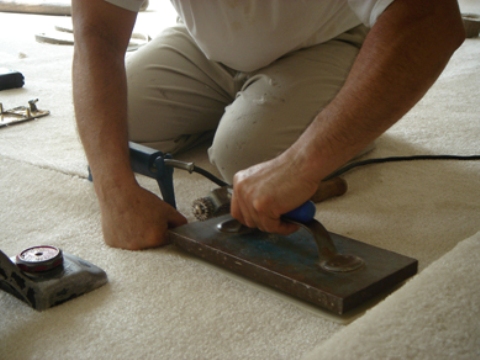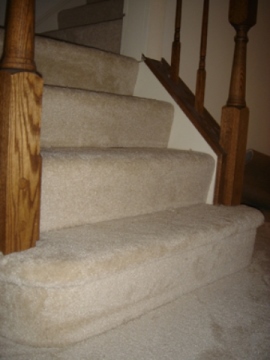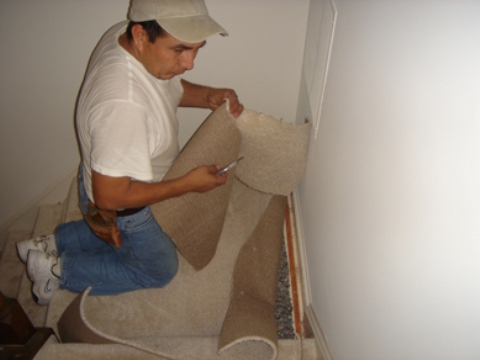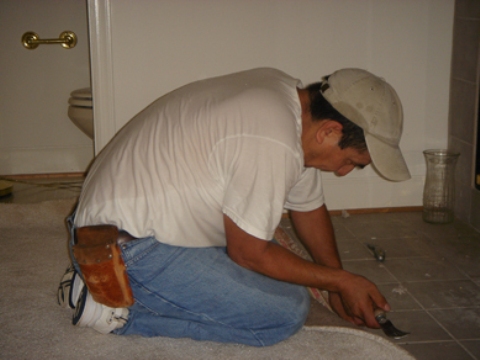Carpet Sales and Installation
We sell carpets from the leading manufacturers. Select a carpet from the manufacturer's websites below and contact us. We will show you a sample for a selected carpet at a showroom. The showroom has most of carpet samples presented at the manufacturer's websites below, thousands of samples. If we do not have a sample at the showroom, we will order it from the manufacturer.
We provide residential and commercial carpet installation. Our consultations are free. At a consultation, we will arrive to your home, take measurements, show you samples of commonly used carpets, and tell you about features of different kinds of carpets.
How to Choose a New Carpet
Buying new carpeting is a major investment for most people. Yet, for a big ticket item that is such a key decorative element in the home, many people don't spend enough time during the selection process and wind up buying a carpet that is not suitable for their lifestyle. They quite often end up unhappy with the performance of their carpeting, which is one of the major reasons why people often choose alternative floor coverings, such as tile, wood, or vinyl.
Often, consumers are mislead by carpet store salespeople, who may push certain brands or styles that they make a higher profit margin from, or are overstocked on. The salesperson's recommendation is not always the carpet that will work best for the customer.
This article will cover several factors to consider when looking for new carpeting. Hopefully, we can help you to make a selection that best suits your home and your budget.
Use
When shopping for a new carpet, you need to ask yourself the following questions:
- How is the room going to be used?
- Will it have heavy or light foot traffic?
- Will the room be the center of activity for family and entertaining?
- Is there direct access from outside, or is the room away from entrances?
- Will the carpet receive direct sunlight?
Cost
Your budget and your needs are key elements in selecting a new carpet. Ask yourself how long you plan on staying in your home or how long you would like your new carpeting to last before you replace it. If the answer to either question is 5 years or less, buy a moderate grade of carpeting.
A better grade of carpet will give you a longer length of service than one of lesser quality. Buy the best carpet you can afford for the heavy traffic areas of your home family room, dining room, hallways, and stairs. A medium grade is sufficient in rooms with less traffic bedrooms and guest rooms. Many manufacturers sell different grades of the same color and style, making it easy to use different grades in your home, while maintaining a consistent appearance in all rooms.
When obtaining a cost estimate from a retailer, make sure that the estimate includes carpet cushion, professional installation, moving of furniture, and the removal and disposal of your old carpeting.
Color
Color selection can be a very personal choice. Lighter colors make a room seem larger, darker colors provide coziness. Light colors allow much more flexibility in decorating options. Medium and darker colors, tweeds and textures will help disguise common soil in your home's high traffic areas. Are you selling your home soon? Choose a lighter, neutral color. Studies have shown that homes with darker colored carpets, on average, take longer to sell.
In general, a bright fiber will show footprints more than a mid-bright because of the difference in color between the ends and side of the tuft.
Fiber Content
The four major types of carpet pile fiber are nylon, olefin (polypropylene), polyester, and wool.
-
Nylon - Approximately 65% of all carpets sold in the United States are made from Nylon. We highly recommend Nylon because of its wear resistance, ease in cleaning, ability to hold up in heavy traffic areas, and ability to hide soil and stains. However, nylon carpets are prone to fading in rooms that receive an abundance of direct sunlight.
-
Olefin (Polypropylene) - Moisture and fade resistant, Olefin is cheaper to manufacture than Nylon. Many Berber style carpets are made from this fiber. Negatives: Melts easily at lower temperatures, sometimes simply by the friction created while dragging furniture across it. Difficult to clean, it is "oil loving" meaning it absorbs oily stains but will repel water based cleaners. Olefin carpets tend to show wear sooner in traffic areas.
-
Polyester - Noted for its luxurious, soft feel when used in thick, cut pile textures, Polyester carpets, like Olefin, are more difficult to clean. Polyester fibers are prone to prematurely showing wear in traffic areas.
-
Wool - Probably the longest wearing of all carpet fibers, Wool is also the most expensive. If it is within budget, consider a blend of both Nylon and Wool fibers. This blend combines the durability of Wool with the "cleanability" of Nylon.
BCF or Staple?
When it comes to durability, there is little difference between bulked continuous filament (BCF) or staple (spun) fibers. The difference lies in the length of the fibers in the yarn, with staple having shorter lengths, giving the yarn more bulk (sometimes described as being more like wool).
When carpet is manufactured with staple fiber, there will be initial shedding of shorter fibers. It will soon stop, depending on the amount of foot traffic and the frequency of vacuuming. Wool is a naturally staple fiber, Nylon and Polyester can be staple or continuous filament, and Olefin (Polypropylene) is usually BCF.
The Most Common Types of Carpet Construction
Cut - The loops of a cut pile carpet are cut to expose the yarn ends. You will find cut piles in a variety of styles to suit any room in your home.
-

Velvet-Plush - This rich, luxurious surface is styled for any room with little traffic.
-

Saxony - Great for a less formal room such as a family room or den, but they will show footprints more easily than a textured style.
-

Textured Saxony - They're tough enough for any room and the sculpted design will not show dirt or footprints easily.
-

Frieze - A smart choice for any high traffic area (family rooms, foyers, or kids rooms). They are less likely than other cut styles to show vacuum marks or footprints.
Loop - Loop carpets are marked by a continuous uncut surface that resists crushing and matting. Berber style loop carpets, however, wear well and are suited for any room.
-

Level Loop
-

Multi-Level Loop
Cut and Loop - Cut and Loop carpets combine these two carpet piles, usually in a sculpted pattern. Often multi-colored, they're styled for any room setting except the most formal.
-

Cut and Loop
Performance glossary
Density - Refers to the amount of pile yarn in the carpet and the closeness of the tufts. The denser, the better.
Twist - The winding of the yarn around itself. A tighter twist provides enhanced durability.
Heat-Setting - The process that sets the twist by heat or steam, enabling yarns to hold their twist over time. Important in cut pile carpet. Most Nylon, Olefin, and Polyester cut pile carpets are heat-set.
Performance - Some manufacturers have a rating scale for choosing carpet for various traffic areas high, moderate, or low.
It's Smarter to Be Dense
Carpet pile is the yarn on the face of the carpet. A quality carpet is marked by a firm, dense pile. To check a carpet's density, bend a corner of the carpet and see how much backing shows. The more backing that shows, the less dense and durable your carpet is.
Carpet Cushion
Never cut costs when choosing a carpet pad. A good quality pad will extend the life of your carpet while making it feel more luxurious. Make sure that the pad you select is recommended for your particular style of carpet. Installing the wrong pad may void your manufacturer's warranty.
For most residential carpet applications, choose a cushion no thicker than 7/16" that is rebond padding weighing 6 lbs or more. If the carpet is a Berber or low profile carpet, choose a cushion no thicker than 3/8" that is rebond padding weighing 8 lbs or more.
If you need further advice, feel free to call us today at 703-481-1261. See also FAQs at the Carpet and Rug Institute.
Some of this information in this article was obtained from The Carpet & Rug Institute or adapted from the Wear Dated Carpet How to Buy Carpet for the Real World brochure.
Client Testimonials
-
"Thanks a million for the wonderful job you did with our mold removal wet front room and to make it safe and dry. The new carpet looks wonderful. We appreciate all your hard work and many visits to our home to complete the job!
We also were happy to see we won the contest for the movie tickets. That was so fun to get in the mail. Thank you very much."
~Brad & Patricia Keck, Herndon, VA
-
"Called Tu's group after receiving a flyer. Very responsive, came and did an estimate the next day. Owner (Peter) and his wife (Ruby) came in person and did a thorough walk-thru in order to do the estimate. Afterwards explained in great detail about their different service levels, warranties. Had carpet samples in car and the different qualities and pros/cons were explained also in great detail. Agreed on price (seemed reasonable but have nothing to compare to) and date. On the appointed day they came at the agreed time and spent the whole day on the job, more than I had expected. This was not just some cheap carpet cleaner they had rented at the local giant, the machines were sophisticated and they brought dryers etc. continue...
~Thomas Smitt, Vienna, VA
-
(Continued) Carpets looked great after the job, a couple of tough spots were untreatable but to Tu's defense, they tried about 10 different things on the spots, but they got rid of 95% of the spots. After the job was done, Peter explained what to do next and gave good tips on carpet maintenance. The carpet install was a couple of days later and the service was again prompt and impeccable. Very nice job, would definitely use the Tu's group again."
~Thomas Smitt, Vienna, VA
-
"The Tu's Group is great. They are honest and do a great, thorough job. We have had them replace carpets, clean carpets, and refinish hardwood floors. They are always reasonably priced (actually cheap) and Peter is always honest and hard working. We ask his advice whether to clean or replace carpets and he will give us the honest answer rather than the more expensive one. We have referred them to many of our friends and they have used them multiple times and referred them to their friends. Highly recommend them!!!!"
~Ian and Ethel Chun, Reston, VA
-
"I was very happy with the service of your company. Everyone that I dealt with (from consultation to installation) was extremely knowledgeable and interested in my satisfaction. The carpeting is beautiful and the installation was very efficient and professional."
~Elizabeth Thomas, Reston, VA
-
"The Tu's Group installed wall to wall carpeting in a massive lower level area of my home. The pattern repeat of the carpet was wide and difficult to work with, matchup was perfect. Peter (owner) measured the area perfectly and was very professional at our initial meeting. I met with five individuals from different companies before selecting The Tu's Group. Not one was even half as good as Peter and his staff. I cannot say enough about the quality of the job. The installation crews were superb. The expert installer, David is very experienced and tackled the job with professionalism. The entire crew worked extremely hard. If you need a carpet company, call the Tu's Group. You will not be disappointed.
It was the best experience I have ever had with a carpet installation."
~Joanne Nolan, Bethesda, MD
-

"I am an Interior Decorator for Decor & You and use the Tu's Group exclusively for installing both wall-to-wall carpeting and laying area rugs in my client's homes. Peter Tu is very professional and provides accurate measurements on the amount of carpet that is necessary for carpeting a room. His carpet installers are excellent in all aspects from moving the furniture to laying the carpet. My clients and I have all been very happy with their work. When laying an area rug, Peter Tu is very meticulous in cutting the padding and ensuring that the padding is laid precisely underneath the area rug where he wants it. I believe his tolerance is less than 1/8 of an inch. For example the area rug must be 2 inches from each edge of the area rug."
~Janet Aurora, Interior Designer, Decor & You, Vienna, VA
-

"Peter did an amazing job in both my home and the home of clients. My family room carpet was buckling in several areas because the first installer didn't stretch it tightly enough. Peter came and restretched the carpet getting rid of the excess carpet. He then did a great job cleaning a non-child-friendly carpet in my family room. He has also cleaned the carpeting in several of my client's homes and they have always been very pleased."
~Janet Aurora, Interior Designer, Decor & You, Vienna, VA
-
"Hello, Peter, I am writing to express our appreciation for the exceptional services you offered, which have turned our new residence into a cleaner and more comfortable place.
No matter what the job was - carpet cleaning, or airduct cleaning or new carpet installation, you did it very professionally.
What also impressed us is that you were willing to spend time educating us in carpet selection and proper maintenance, which greatly helped us make the right decision and ensures that we will enjoy our new carpet well into the future.
Peter, you are the best!"
~Bingjun and Jie Dai, VA
-
"The carpet installation was done very well, especially the stairs which were installed in a particularly meticulous manner. I showed several of my friends the end results and they each gave the job the highest praise."
~Mary Womack, Seven Corners, VA
-

"I was very satisfied with the outcome and overall carpet installation process; Mr. Tu was on time and kind, and gave detailed information on making a good choice for the kind of carpet that fit my home. Ultimately, the quality of the carpet and service was outstanding."
~Yeong Tsuey Uang, Mother of 3, Herndon, VA
-
"I have been referring clients to The Tu's Group for many years, as well as used their services personally. They are extremely knowledgeable in every aspect of their business, from carpet and hardwood flooring installation, carpet and upholstery cleaning (oriental carpets, too) to mold remediation. They are a trusted business partner for me and I highly recommend their services."
~Barbara Steiner, Associate Broker, ERA Teachers, Inc., Herndon, VA
-
~Gregg Caldwell, Chantilly, VA
Photos
-

Carpet installation
-

Carpet installation
-

Installed carpet
-

Carpet installation
-

Carpet installation
-

Installed carpet
-

Carpet installation
Certification
Your home deserves the best care it can get, and you can rest assured that it will with Tus Group Our specialists are carefully trained and certified by the best organizations in the industry. The following are certifications obtained by Tus Group Owner and President, Peter Tu.
- CFI (Certified Floorcovering Installer)
- RBI International Carpet Consultants
- Commercial Carpet Installation
- Institute of Inspection, Cleaning, and Restoration Certification (IICRC, The CleanTrust)
- Carpet Cleaning
- DuPont Masterseries Carpet Care System
- Host School
- Modern Carpet Maintenance
Our Service Areas
Tus Group provides services in the following areas: Northern Virginia, Loudoun County VA, Prince William County VA, Fairfax County VA, Arlington County VA, Sterling VA, Ashburn VA, Vienna VA, Great Falls VA, McLean VA, Reston VA, Herndon VA, Fairfax VA.














